Page 49 of 436
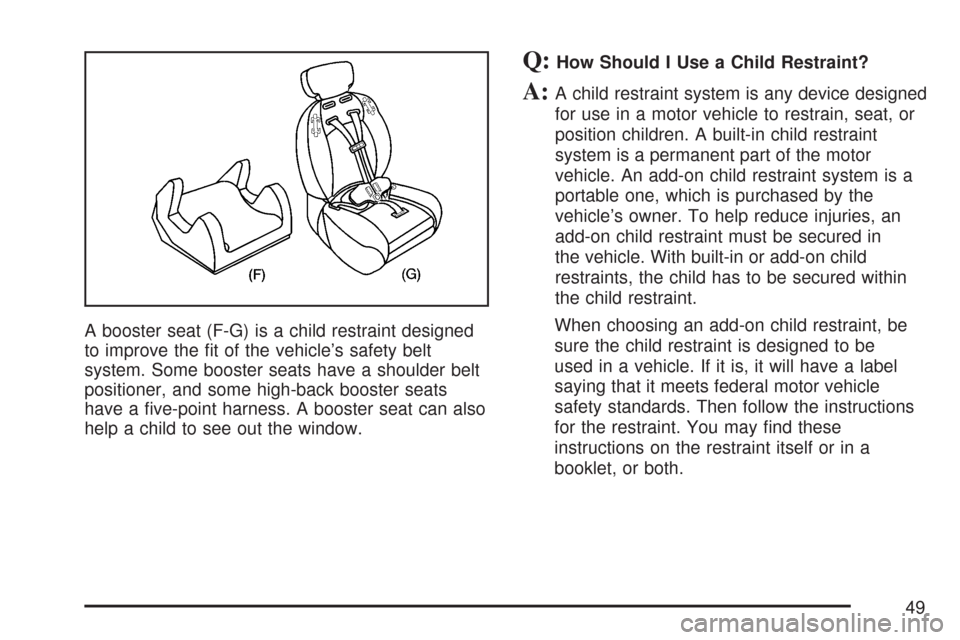
A booster seat (F-G) is a child restraint designed
to improve the fit of the vehicle’s safety belt
system. Some booster seats have a shoulder belt
positioner, and some high-back booster seats
have a five-point harness. A booster seat can also
help a child to see out the window.
Q:How Should I Use a Child Restraint?
A:A child restraint system is any device designed
for use in a motor vehicle to restrain, seat, or
position children. A built-in child restraint
system is a permanent part of the motor
vehicle. An add-on child restraint system is a
portable one, which is purchased by the
vehicle’s owner. To help reduce injuries, an
add-on child restraint must be secured in
the vehicle. With built-in or add-on child
restraints, the child has to be secured within
the child restraint.
When choosing an add-on child restraint, be
sure the child restraint is designed to be
used in a vehicle. If it is, it will have a label
saying that it meets federal motor vehicle
safety standards. Then follow the instructions
for the restraint. You may find these
instructions on the restraint itself or in a
booklet, or both.
49
Page 50 of 436
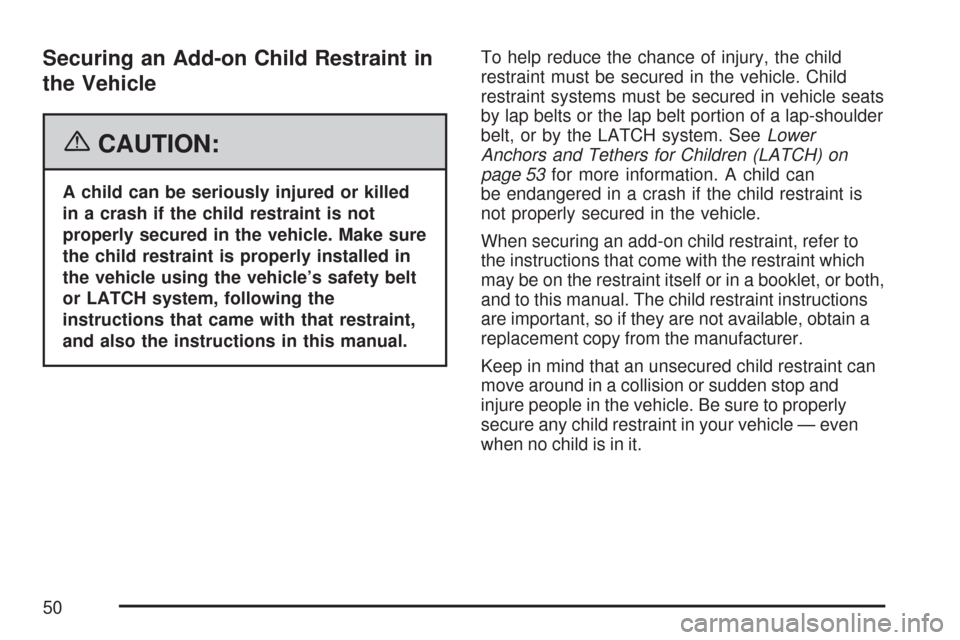
Securing an Add-on Child Restraint in
the Vehicle
{CAUTION:
A child can be seriously injured or killed
in a crash if the child restraint is not
properly secured in the vehicle. Make sure
the child restraint is properly installed in
the vehicle using the vehicle’s safety belt
or LATCH system, following the
instructions that came with that restraint,
and also the instructions in this manual.To help reduce the chance of injury, the child
restraint must be secured in the vehicle. Child
restraint systems must be secured in vehicle seats
by lap belts or the lap belt portion of a lap-shoulder
belt, or by the LATCH system. SeeLower
Anchors and Tethers for Children (LATCH) on
page 53for more information. A child can
be endangered in a crash if the child restraint is
not properly secured in the vehicle.
When securing an add-on child restraint, refer to
the instructions that come with the restraint which
may be on the restraint itself or in a booklet, or both,
and to this manual. The child restraint instructions
are important, so if they are not available, obtain a
replacement copy from the manufacturer.
Keep in mind that an unsecured child restraint can
move around in a collision or sudden stop and
injure people in the vehicle. Be sure to properly
secure any child restraint in your vehicle — even
when no child is in it.
50
Page 52 of 436
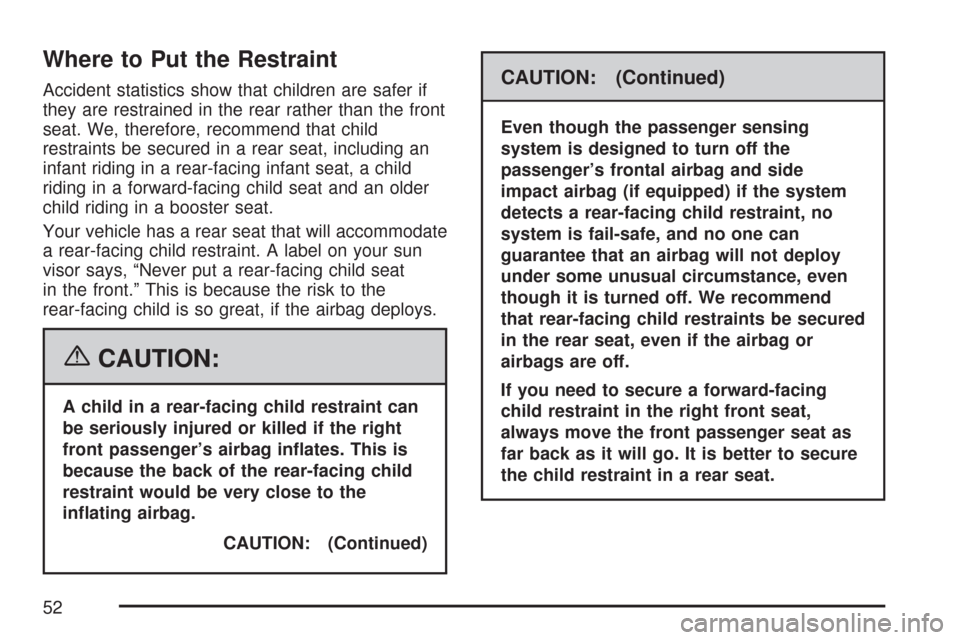
Where to Put the Restraint
Accident statistics show that children are safer if
they are restrained in the rear rather than the front
seat. We, therefore, recommend that child
restraints be secured in a rear seat, including an
infant riding in a rear-facing infant seat, a child
riding in a forward-facing child seat and an older
child riding in a booster seat.
Your vehicle has a rear seat that will accommodate
a rear-facing child restraint. A label on your sun
visor says, “Never put a rear-facing child seat
in the front.” This is because the risk to the
rear-facing child is so great, if the airbag deploys.
{CAUTION:
A child in a rear-facing child restraint can
be seriously injured or killed if the right
front passenger’s airbag in�ates. This is
because the back of the rear-facing child
restraint would be very close to the
in�ating airbag.
CAUTION: (Continued)
CAUTION: (Continued)
Even though the passenger sensing
system is designed to turn off the
passenger’s frontal airbag and side
impact airbag (if equipped) if the system
detects a rear-facing child restraint, no
system is fail-safe, and no one can
guarantee that an airbag will not deploy
under some unusual circumstance, even
though it is turned off. We recommend
that rear-facing child restraints be secured
in the rear seat, even if the airbag or
airbags are off.
If you need to secure a forward-facing
child restraint in the right front seat,
always move the front passenger seat as
far back as it will go. It is better to secure
the child restraint in a rear seat.
52
Page 53 of 436
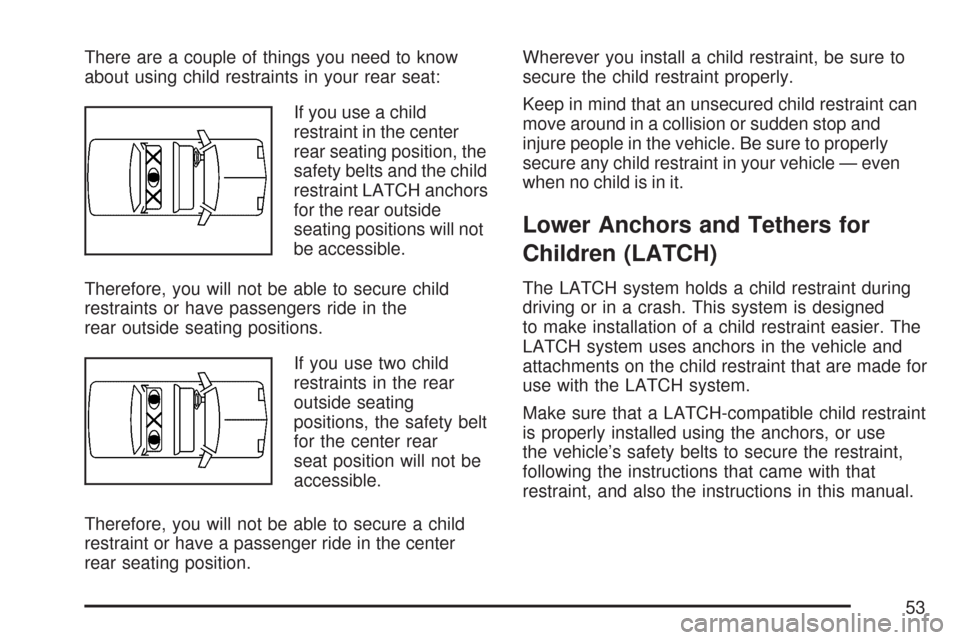
There are a couple of things you need to know
about using child restraints in your rear seat:
If you use a child
restraint in the center
rear seating position, the
safety belts and the child
restraint LATCH anchors
for the rear outside
seating positions will not
be accessible.
Therefore, you will not be able to secure child
restraints or have passengers ride in the
rear outside seating positions.
If you use two child
restraints in the rear
outside seating
positions, the safety belt
for the center rear
seat position will not be
accessible.
Therefore, you will not be able to secure a child
restraint or have a passenger ride in the center
rear seating position.Wherever you install a child restraint, be sure to
secure the child restraint properly.
Keep in mind that an unsecured child restraint can
move around in a collision or sudden stop and
injure people in the vehicle. Be sure to properly
secure any child restraint in your vehicle — even
when no child is in it.
Lower Anchors and Tethers for
Children (LATCH)
The LATCH system holds a child restraint during
driving or in a crash. This system is designed
to make installation of a child restraint easier. The
LATCH system uses anchors in the vehicle and
attachments on the child restraint that are made for
use with the LATCH system.
Make sure that a LATCH-compatible child restraint
is properly installed using the anchors, or use
the vehicle’s safety belts to secure the restraint,
following the instructions that came with that
restraint, and also the instructions in this manual.
53
Page 54 of 436
When installing a child restraint with a top tether,
you must also use either the lower anchors or
the safety belts to properly secure the child
restraint. A child restraint must never be installed
using only the top tether and anchor.
In order to use the LATCH system in your vehicle,
you need a child restraint that has LATCH
attachments. The child restraint manufacturer will
provide you with instructions on how to use
the child restraint and its attachments. The
following explains how to attach a child restraint
with these attachments in your vehicle.
Not all vehicle seating positions or child restraints
have lower anchors and attachments or top
tether anchors and attachments.Lower Anchors
Lower anchors (A) are metal bars built into the
vehicle. There are two lower anchors for each
LATCH seating position that will accommodate a
child restraint with lower attachments (B).
54
Page 57 of 436
For sedan models, the top tether anchors are
located under the trim covers behind the rear seat
on the filler panel. Pull open the cover to access
the top tether anchors. Be sure to use an
anchor located on the same side of the vehicle as
the seating position where the child restraint
will be placed.For hatchback models, the top tether anchors (B)
are located in the rear cargo area, attached to
the back wall (A) of the vehicle. Squeeze and pull
the front part of the plastic cover to access the
top tether anchors. Remove the cargo shade
before installing the top tether. The cargo shade
should remain off while the top tether is in use. Be
sure to use an anchor located on the same side
of the vehicle as the seating position where
the child restraint will be placed.
SedanHatchback
57
Page 58 of 436
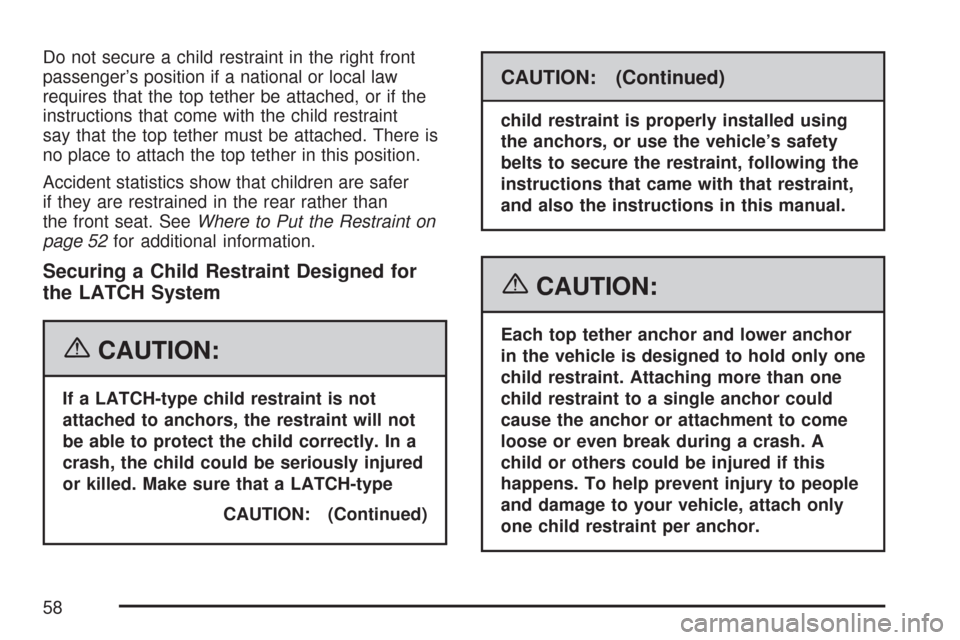
Do not secure a child restraint in the right front
passenger’s position if a national or local law
requires that the top tether be attached, or if the
instructions that come with the child restraint
say that the top tether must be attached. There is
no place to attach the top tether in this position.
Accident statistics show that children are safer
if they are restrained in the rear rather than
the front seat. SeeWhere to Put the Restraint on
page 52for additional information.
Securing a Child Restraint Designed for
the LATCH System
{CAUTION:
If a LATCH-type child restraint is not
attached to anchors, the restraint will not
be able to protect the child correctly. In a
crash, the child could be seriously injured
or killed. Make sure that a LATCH-type
CAUTION: (Continued)
CAUTION: (Continued)
child restraint is properly installed using
the anchors, or use the vehicle’s safety
belts to secure the restraint, following the
instructions that came with that restraint,
and also the instructions in this manual.
{CAUTION:
Each top tether anchor and lower anchor
in the vehicle is designed to hold only one
child restraint. Attaching more than one
child restraint to a single anchor could
cause the anchor or attachment to come
loose or even break during a crash. A
child or others could be injured if this
happens. To help prevent injury to people
and damage to your vehicle, attach only
one child restraint per anchor.
58
Page 59 of 436
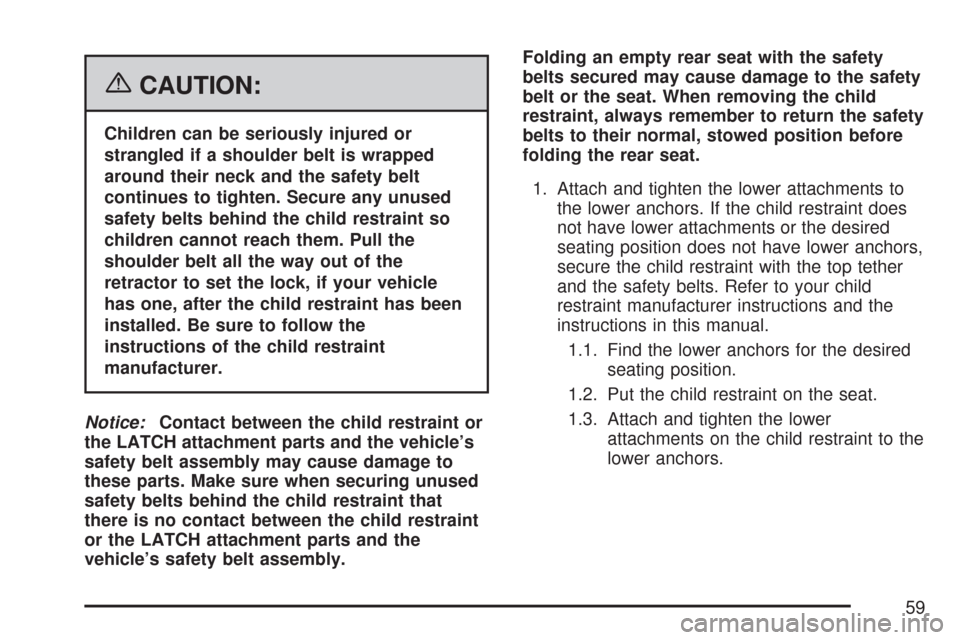
{CAUTION:
Children can be seriously injured or
strangled if a shoulder belt is wrapped
around their neck and the safety belt
continues to tighten. Secure any unused
safety belts behind the child restraint so
children cannot reach them. Pull the
shoulder belt all the way out of the
retractor to set the lock, if your vehicle
has one, after the child restraint has been
installed. Be sure to follow the
instructions of the child restraint
manufacturer.
Notice:Contact between the child restraint or
the LATCH attachment parts and the vehicle’s
safety belt assembly may cause damage to
these parts. Make sure when securing unused
safety belts behind the child restraint that
there is no contact between the child restraint
or the LATCH attachment parts and the
vehicle’s safety belt assembly.Folding an empty rear seat with the safety
belts secured may cause damage to the safety
belt or the seat. When removing the child
restraint, always remember to return the safety
belts to their normal, stowed position before
folding the rear seat.
1. Attach and tighten the lower attachments to
the lower anchors. If the child restraint does
not have lower attachments or the desired
seating position does not have lower anchors,
secure the child restraint with the top tether
and the safety belts. Refer to your child
restraint manufacturer instructions and the
instructions in this manual.
1.1. Find the lower anchors for the desired
seating position.
1.2. Put the child restraint on the seat.
1.3. Attach and tighten the lower
attachments on the child restraint to the
lower anchors.
59